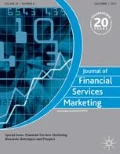Abstract
The possibility of random response occurring, which can result in Type II errors, is possible whenever a financial risk-tolerance questionnaire is administered. This study was designed to apply inter-item standard deviation (ISD) scores, as introduced by Marjanovic, Holden, Struthers, Cribbie, and Greenglass (2015), to identify responders to a financial risk-tolerance questionnaire as hyper-consistent, conscientious, or random. Hyper-consistent responders were found to be more likely to be older married men who make their own financial and investment decisions. Those classified as hyper-consistent exhibited the lowest risk-tolerance scores. Conscientious responders were more likely to report having a high level of attained education and to rely on someone else when making financial and investment decisions. Financial risk-tolerance scores for conscientious responders fell between scores for hyper-consistent and random responders. Random responders were found to be younger, single, less well educated, and more likely to hold cash in their portfolio. Random responders also exhibited the highest financial risk-tolerance scores among participants in this study.
Similar content being viewed by others
Notes
The Sandler Report, Medium and Long-term Retail Savings in the UK: A Review (2002) (‘Sandler Report’). See also: https://api.parliament.uk/historic-hansard/commons/2002/jul/09/retail-savings-sandler-review.
References
Agresti, A. 2010. Analysis of Ordinal Categorical Data, 2nd ed. Hoboken, NJ: Wiley.
Certified Financial Planner Board of Standards Inc. 2018. Code of Ethics and Standards of Conduct, March 2018. Washington, DC: CFP Board.
Clark-Murphy, M., and G.N. Soutar. 2008. Do retail stockbrokers understand clients’ investment preferences? Journal of Financial Services Marketing 13: 135–149.
Fonseca, R., K.J. Mullen, G. Zamaro, and J. Zissimopoulos. 2012. What explains the gender gap in financial literacy? The role of household decision making. Journal of Consumer Affairs 46: 90–106.
Grable, J.E., A.C. Lyons, and W. Heo. 2019. A test of traditional and psychometric relative risk tolerance measures on household financial risk taking. Finance Research Letters 30: 8–13.
Grable, J.E., and R.H. Lytton. 1999. Financial risk tolerance revisited: The development of a risk assessment instrument. Financial Services Review 8 (3): 163–181.
Grable, J., Roszkowski, M., Joo, S., O’Neill, B., & Lytton, R. (2006). How well do individuals assess their own risk tolerance? An empirical investigation. Consumer Interests Annual, (American Council on Consumer Interests), 52, 229. [WWW document] URL: www.consumerinterests.org/files/public/Grable_HowWellDoIndividualsAssessTheir
Hari, J., E. Pirsch, and H. Rawitzer. 2018. Women are scaredy-cats and mean are conquerors? Journal of Financial Services Marketing 23: 128–139.
Hatch, C.D., K. Carlson, and W.G. Droms. 2018. Effects of market returns and market volatility on investor risk tolerance. Journal of Financial Services Marketing 23: 77–90.
Hirschl, T.A., J. Altobelli, and M.R. Rank. 2003. Does marriage increase the odds of affluence: Exploring the life course probabilities. Journal of Marriage and Family 65: 927–938.
Ho, K., M.A. Milevsky, and C. Robinson. 1994. Asset allocation, life expectancy and shortfall. Financial Services Review 3: 109–126.
Huang, J.L., P.G. Curran, J. Keeney, E.M. Poposki, and R.P. DeShon. 2012. Detecting and deterring insufficient effort responding to surveys. Journal of Business and Psychology 27: 99–114.
Kuzniak, S., A. Rabbani, W. Heo, J. Ruiz-Menjivar, and J.E. Grable. 2015. The Grable and Lytton risk tolerance scale: A 15-year retrospective. Financial Services Review 24: 177–192.
Marjanovic, Z., Struthers, W., Cribbie, R., & Greenglass, E. R. (2014). The conscientious responders scale: A new tool for discriminating between conscientious and random responders. Frontiers in Psychology. doi.org/10.1177/2158244014545964
Marjanovic, Z., R. Holden, W. Struthers, R. Cribbie, and E. Greenglass. 2015. The inter-item standard deviation (ISD): An index that discriminates between conscientious and random responders. Personality and Individual Differences 84: 79–83.
Meade, A.W., and S.B. Craig. 2012. Identifying careless response in survey data. Psychological Methods 17: 437–455.
Nairn, A. 2005. Beyond Sandler: Risk tolerance and the UK investment deficit. Journal of Financial Services Marketing 9: 375–389.
Nobre, L.H.N., and J.E. Grable. 2015. The role of risk profiles and risk tolerance in shaping client decisions. Journal of Financial Service Professionals 69 (3): 18–21.
Rabbani, A., O’Neill, B., Lawrence, F., & Grable, J. (2018). The investment risk tolerance assessment: A resource for extension educators. Journal of Extension, 56(7), [7TOT4].
Robbins, T. 2014. Money: Master the Game–7 Simple Steps to Financial Freedom. New York: Simon & Schuster.
Yao, R., and S.D. Hanna. 2004. The effect of gender and marital status on financial risk tolerance. Consumer Interests Annual 50: 123–124.
Acknowledgements
The authors wish to acknowledge Dr. Barbara O’Neill for her help in collecting data used in this study.
Author information
Authors and Affiliations
Corresponding author
Additional information
Publisher's Note
Springer Nature remains neutral with regard to jurisdictional claims in published maps and institutional affiliations.
Electronic supplementary material
Below is the link to the electronic supplementary material.
Rights and permissions
About this article
Cite this article
Grable, J.E., Heo, W. & Rabbani, A. Characteristics of random responders in a financial risk-tolerance questionnaire. J Financ Serv Mark 26, 1–9 (2021). https://doi.org/10.1057/s41264-020-00078-6
Received:
Revised:
Accepted:
Published:
Issue Date:
DOI: https://doi.org/10.1057/s41264-020-00078-6




